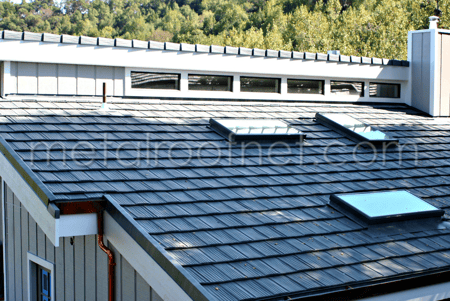We hear this question a lot, and what people are really asking is whether a metal roof makes a house too hot. Here's what we tell them.
 Too Hot?
Too Hot?
There are two elements that affect temperature within a home or building. These are the roof covering material and the roof assembly construction. When you're questioning the heat absorbency of metal, here's what to consider.
- Finish and color. These will both affect a metal's heat absorbancy. Metal exposed directly to the sun, as it is on the roof, will definitely heat up. But whether or not it heats up more or less than other roofing materials is directly related to color and finish. Here at Metal Roof Network, we sell metal roof products with Energy Star finishes certified as sunlight-reflective, which actually makes them less cooler than the older finishes. As for color, you might have already guessed - lighter colors absorb less heat than darker colors.
- Absorption. It's true that a metal roof will absorb heat when directly exposed to the sun. But the same is true of any roof covering material! Materials like asphalt, ceramic, slate or any other material, particularly in darker shades, absorb heat at roughly the same rate as metal. Using the color in a different material likely wouldn't offer a significant different in roof-top temperature.
- Cooling ability. When the sun stops directly shining on a roof, the lightest material will lose heat the fastest. Any guesses as to the lightest roofing material? It's metal, which means a metal roof is the quickest to cool down. Once the sun stops shining on a metal roof, it quickly reverts to the same temperature as the surrounding air. The denser mass of heavier materials like slate or concrete mean they retain heat much longer. And here's the important part - the longer these roofs stay hot, the more heat they'll transfer to the buildings they cover.
ROOF ASSEMBLY CONSTRUCTION
While roof color and material affect the amount of heat collected by the roof, the biggest contributor to the transference of that heat into the rooms beneath it isn't actually the roof. It's the construction between the roof and the space below.
If there's attic space between the roof and the rooms below, controlling the temperature of the attic with a "cool" roof like metal is a smart decision. But properly ventilating the attic to keep it within few degrees of the ambient air temperature is critical. That's what gives the insulation in the ceiling the best chance of keeping heat from seeping into a room. If you're sure your attic is properly ventilated, the second biggest consideration is ceiling insulation. The better the quality and quantity, the less heat from the attic will be conducted into the room below during summer months (and the less heat conducted the other way in the winter!).
A SIMPLE TEST
You can check to see if the heat in a room is coming from the ceiling, or just accumulating by convection from other areas of the house, with a digital thermometer. Just take the temperature of the ceiling, walls and floors in different rooms of your house to see where heat is highest. It's an inexpensive and simple way to quickly learn a lot.
Have a roofing question? Check our Resources page for our re-roofing booklet and comparison sheets.



